Home Remedies to Fix Slow Bathroom Sink Drains
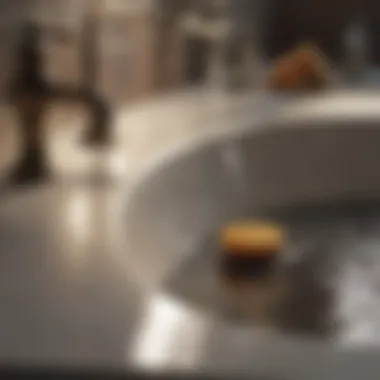
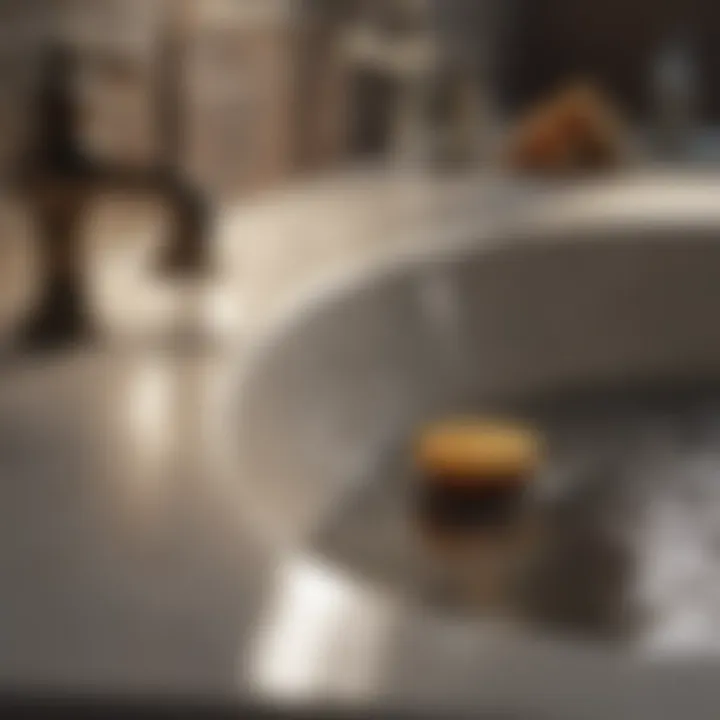
Intro
A slow-draining bathroom sink can be more than just a minor inconvenience; it disrupts your daily routine and can lead to greater issues if not addressed promptly. Understanding the causes behind this common problem can arm you with the knowledge to tackle it effectively. In this article, we will delve into various home remedies that utilize natural ingredients and methods to enhance the performance of your sink, all while steering clear of harsh chemicals that might damage your plumbing.
You might be wondering why this matters. Well, maintaining a clean and efficient bathroom is crucial for overall hygiene and comfort. Plus, relying on more environmentally friendly options contributes to a healthier home and planet. From baking soda to vinegar, the solutions we'll explore not only help in unclogging your sink but also promote the longevity of plumbing fixtures. Let’s roll up our sleeves and dive into the nitty-gritty of resolving this pesky issue—without ever needing to call in a plumber!
Understanding the Cause
Before jumping into remedies, it's essential to pinpoint what usually causes your sink to slow down. Here are a few culprits:
- Hair: A common plumbing villain, hair can latch onto internal pipes, causing blockages.
- Soap Scum: Over time, soap residue builds up, creating a gooey film that traps debris.
- Mineral Buildup: If you live in an area with hard water, minerals can deposit in your pipes, narrowing them and slowing water flow.
By grasping these issues, you will not only be in a better position to tackle the problem but also take preventative measures to keep your sink running smoothly.
Home Remedies for Slow Draining Sinks
With the underlying causes in mind, let’s explore effective home remedies that can help you overcome slow drains. Feel free to gather your supplies as we walk through these straightforward techniques.
Baking Soda and Vinegar Method
This classic combo is as simple as it is effective. To start:
- Start by pouring a pot of boiling water down the drain to loosen any debris.
- Next, add half a cup of baking soda into the drain.
- Follow with half a cup of vinegar. You’ll hear a fizzing sound—that’s what you want!
- Wait 15-30 minutes.
- Lastly, flush with another pot of boiling water to wash away the residue.
Note: If you use this method regularly, it can help prevent further clogs.
Salt and Baking Soda
If you prefer a more granular approach, consider using salt with baking soda. Here’s how:
- Mix a quarter cup of salt with a quarter cup of baking soda.
- Pour this mixture down the drain, followed by a pot of boiling water.
- The abrasive nature of salt can effectively scrub away any buildup in the pipes.
Dish Soap and Hot Water
For greasy clogs, dish soap can work wonders. Here is the simple process:
- Pour a generous amount of dish soap into the drain.
- Follow it up with a pot of boiling water.
- Let it sit for a few minutes and rinse with warm tap water.
This method is especially beneficial for those who tend to wash oily residue down the sink.
Preventive Measures
To keep your sink functioning optimally, consider practicing these preventive tips:
- Install a Drain Screen: Keeping hair and larger debris out of the drain can stop clogs before they start.
- Rinse with Hot Water: Once a week, flush your drain with hot water to help dissolve any buildup.
- Be Mindful of What You Flush: Avoid sending items like wipes, cotton swabs, and food down the drain.
Ending
Navigating the waters of drainage issues doesn't have to be a daunting task. By familiarizing yourself with both the common causes of slow drains and exploring effective home remedies, you can maintain a smooth and functional bathroom experience. Remember, these techniques are not just for fixing current problems; they can help create a proactive approach to keeping your plumbing in tip-top shape.
Understanding the Causes of Slow Bathroom Sink Drains
When it comes to tackling the pesky problem of slow bathroom sink drains, it's crucial to understand the underlying causes. Being aware of what's behind the blockage not only helps in choosing the right remedy but also allows you to take preventative actions. After all, prevention is often better than cure, especially when you are dealing with the inconvenience of water pooling in your sink.
Common Clogs and Their Origins
Clogs can spring up from a variety of sources, turning an ordinary task like washing your hands into an exercise in frustration. One of the most frequent offenders is hair. It doesn’t take much; even small strands can weave together into a mighty mat, creating a barrier to water flow. Beyond hair, objects like toothpaste caps or a tiny piece of soap can find their way into drains too. It’s a chaotic mishmash of everyday items that can compounded over time.
Moreover, food particles, while usually associated with kitchen sinks, can find their way into bathroom sinks via brushes and washcloths. In a way, it's like a surprise party for your pipes – however, they never look forward to these unexpected guests. A good practice is to use drain covers to catch debris before it slips away.
Impact of Hair and Soap Buildup
Hair tends to play a starring role when it comes to clog formation. Combine it with soap residue, and you have a recipe for disaster. The combination creates a thick paste that can harden and glue itself to the sides of pipes, reducing the flow of water dramatically. There's the visual of a tangled mess buried deep within the plumbing, and that’s only the tip of the iceberg.
Over time, soap scum builds up and solidifies, complicating matters further. This duo not only slows down drainage but can also lead to unpleasant odors. Regular cleaning can help mitigate this, but even the most diligent among us can sometimes overlook those hidden areas.
The Role of Hard Water Deposits
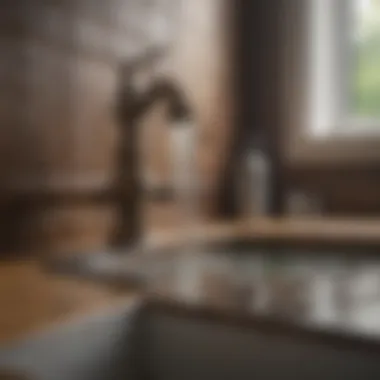
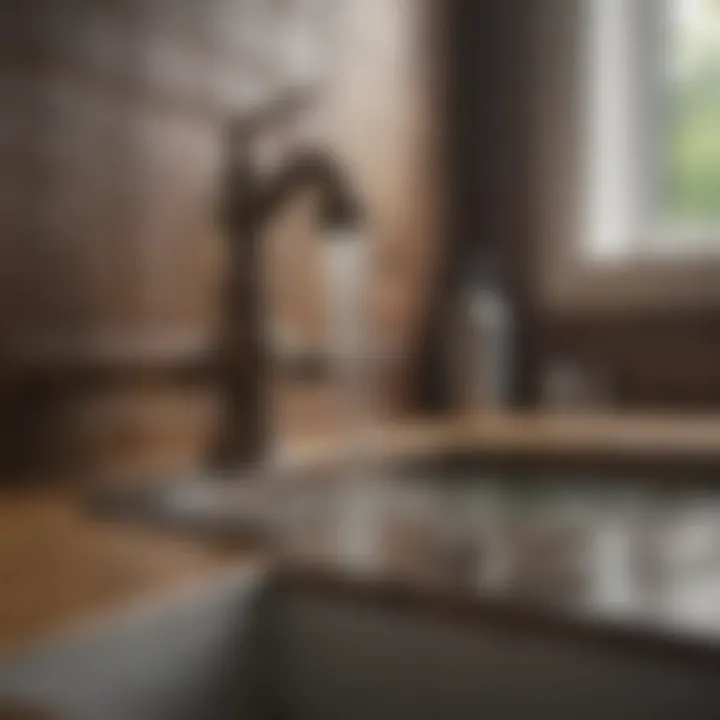
Hard water is often the unsung villain in the story of a slow drain. Loaded with minerals like calcium and magnesium, hard water can leave behind deposits, creating a gritty buildup inside your pipes. This mineral accumulation can narrow the passage through which water flows, and it can build up surprisingly quickly. Think of it like unexpected roadblocks in an otherwise smooth journey.
For homeowners in areas with hard water, investing in a water softener can not only improve plumbing efficiency but also extend the life of your faucets and appliances. A bit of awareness here can save you plenty of headaches down the line.
Environmental Factors Affecting Drainage
Sometimes it's not just about what's inside the pipes but what's outside as well. Environmental factors can play a significant role in the efficiency of your drainage system. For instance, the overall plumbing system’s age and design can affect how quickly water drains. Older pipes often aren’t as smooth inside, which can exacerbate slow drainage issues.
Additionally, extreme weather conditions can also have an impact. Heavy rains might overwhelm systems that aren’t equipped for it, leading to potential backups. Homeowners should be mindful of how external conditions affect their indoor plumbing and consider routine checks to avert bigger issues.
Understanding these various causes provides a solid foundation for addressing and remedying slow bathroom sink drains. With a bit of awareness and proactive measures, you can keep your sinks flowing smoothly.
Overview of Home Remedies
When faced with a slow bathroom sink drain, it can feel like a pebble in your shoe—annoying but often ignored until it becomes a larger issue. The topic of home remedies for drain problems is not merely about immediate fixes; it encompasses a deeper understanding of the materials available in your home that can effectively address this pervasive issue. This section serves as an insightful entry point into exploring how natural remedies can revive your clogged plumbing without the harsh effects of chemical cleaners.
Being able to rely on accessible solutions is a significant aspect of home care. Natural remedies stand out in this context, as they not only tackle blockages but also promote a healthy environment. Homeowners often overlook the impact of commercial products, which can sometimes lead to more significant problems such as pipe damage or harmful chemical accumulation. The reason this topic is important is that it pushes forward an agenda of sustainability.
By understanding these remedies, you can make smarter choices that are not just cost-effective, but also environmentally friendly. Below, we’ll outline some specific elements at play.
Natural Solutions Versus Chemical Cleaners
In the ongoing debate between natural solutions and chemical cleaners, it's crucial to recognize the pros and cons of each side. Chemical cleaners, often packed with potent agents, might offer immediate results for a troublesome drain. However, these short-term fixes can come with a hefty price. They may erode pipes over time, pose health risks, and even exacerbate drainage issues due to residue.
On the other hand, natural solutions harness everyday household items like baking soda, vinegar, or even simple salt. These are gentler alternatives for your plumbing system, helping to break down debris without inflicting damage. Here’s why natural solutions can be a far better choice:
- Safety: They are generally less harmful to both humans and pets.
- Eco-friendliness: Reduce the burden on local water systems and treatment facilities.
- Economical: Most suggested items are often right in your kitchen or pantry.
To further emphasize, it's worth noting a study on the effects of prolonged use of harsh chemicals, showing that nearly 60% of households reported increased plumbing issues due to routine use.
Why Choose Home Remedies?
The benefits of opting for home remedies extend beyond mere practicality; they resonate with deeper values around self-sufficiency and resourcefulness. When you engage in tackling your drain issues with home remedies, there's a certain empowerment that comes along, knowing that you can resolve a problem without needing to rely on store-bought solutions.
Home remedies showcase a practical application of common sense, using what’s readily available in your surroundings. They can mitigate the wasteful cycle of purchasing unnecessary products and then disposing of the resulting containers, aligning with minimalist and environmentally-conscious living.
Additionally, many traditional remedies have historical significance, passed down through generations. Aspects of ancestral wisdom often become lost in the craze of commerciality, but rediscovering these methods can provide a sense of connection to the past while effectively resolving present issues.
In summary, choosing home remedies for your slow bathroom sink drain is neither an insignificant step nor just a temporary patch. It embodies a holistic approach to home maintenance that values sustainability, safety, and self-reliance. We’ve discussed some compelling reasons to favor these remedies, but it's vital to understand that putting them into practice can yield measurable long-term benefits.
"An ounce of prevention is worth a pound of cure."
This adage holds particularly true when we consider how preventive measures can keep your drains flowing smoothly without resorting to harsh chemicals.
Baking Soda and Vinegar Method
The combination of baking soda and vinegar has long been touted as a reliable home remedy for a variety of household issues, and slow bathroom sink drains are no exception. This method not only utilizes common household ingredients but also offers an eco-friendly alternative to harsh chemicals. Baking soda acts as a slight abrasive, helping to break down gunky buildup, while vinegar's acidity can dissolve minor clogs and neutralize odors. The fizzing reaction that occurs when combining these two ingredients also aids in loosening debris stuck in the pipes.
Utilizing baking soda and vinegar for drain maintenance may feel a bit like alchemy, but it’s crucial for combating everyday wear and tear. It’s particularly helpful for addressing the common causes of slow drains, from hair to soap scum. Overall, this method is an invaluable addition to any homeowner's toolkit.
Preparing the Mixture
Creating the right mixture of baking soda and vinegar is the first step in the process. You’ll need to gather your supplies:
- 1/2 cup of baking soda
- 1/2 cup of white vinegar
- Measuring cup
- Cloth or rag (to cover the drain)
Start by measuring out 1/2 cup of baking soda. The fine granules are key for ensuring it can get into all the nooks and crannies of the drain. Next, pour the baking soda directly into the sink drain. Allow a few moments to pass, letting the baking soda settle into any potential clogs. Following this, measure out 1/2 cup of white vinegar. The blend of these two ingredients will create a bubbling reaction, so prepare for the fizz!
Step-by-Step Application
Executing the baking soda and vinegar method involves just a few straightforward steps:
- Clear any visible debris: Before starting, remove any hair or large particles from the drain. This will make the process more effective.
- Add the baking soda: Pour the measured baking soda into the drain, ensuring it goes down as much as possible.
- Follow with vinegar: After the baking soda settles, gently pour the vinegar down the drain. You should immediately see and hear a bubbly reaction.
- Cover the drain: Quickly cover the drain with a cloth or rag to keep the reaction focused inside. Let it sit for about 15-30 minutes; this is a critical part where the magic happens.
- Flush with hot water: After the waiting period, boil some water and pour it down the drain. This helps rinse away the loosened debris and any remaining baking soda or vinegar.
Anticipated Results and Follow-Up
Following this method, you should notice an improvement in your bathroom sink's drainage. The combination of baking soda and vinegar works effectively for minor clogs, especially if used routinely as preventive maintenance. However, results can vary depending on the severity of the issue. If the sink still drains slowly, it might mean there's a more severe blockage deeper in the plumbing system, which could require a different solution.
It's recommended to use this method every couple of weeks for optimal results. By sticking with this regime, you'll keep your drains free-flowing and minimize build-up, ultimately avoiding bigger headaches down the line.
"Regular maintenance can save you from costly professional interventions."
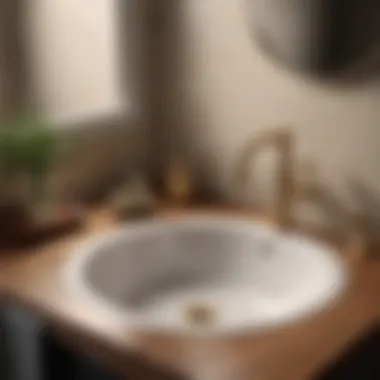
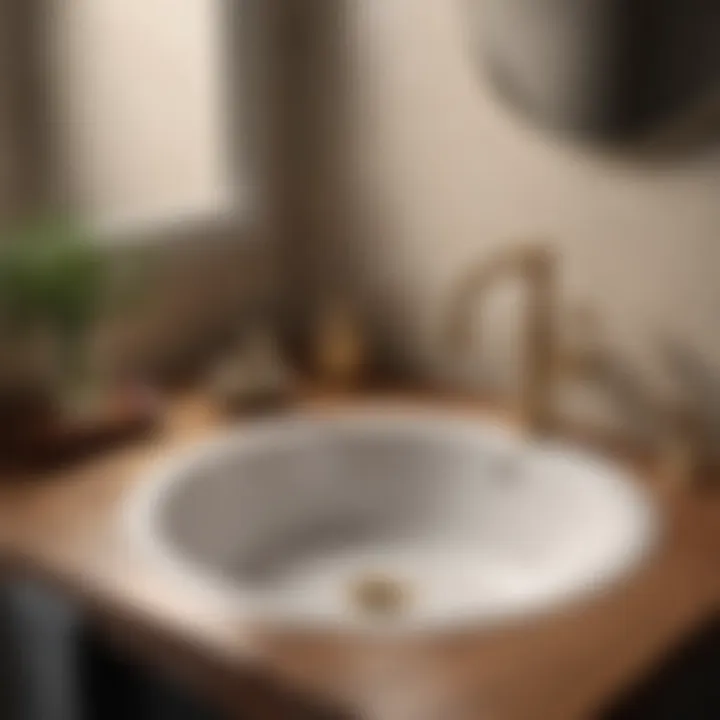
When using this remedy, keep track of your sink's performance after each use to gauge effectiveness. If you notice persistent drainage problems, consider complementing this method with additional strategies, such as using enzyme cleaners or salt and hot water.
By using these simple ingredients and following these steps, you can maintain clear bathroom sink drains while steering clear of potentially harmful chemical cleaners.
Salt and Hot Water Rinse
When it comes to tackling slow bathroom sink drains, the salt and hot water rinse method is a hidden gem in the panoply of home remedies. It’s efficient, easy to implement, and makes use of common household items. This simple technique works wonders for alleviating stubborn clogs. Understanding the science behind it can help homeowners appreciate its effectiveness and why they should keep it in their cleaning arsenal.
Why Salt Works Effectively
Salt does more than just add flavor to your meals; its crystalline structure makes it an excellent abrasive agent. When dissolved in hot water, salt helps to break down buildup from soap, grease, and minerals that can accumulate over time.
- Abrasion: The rough edges of salt particles physically scrub the insides of pipes as they flow through, helping to dislodge sticky clogs.
- Chemical Reaction: When mixed with hot water, salt can react with other materials (like baking soda) in subsequent cleaning methods, enhancing their ability to dissolve any remaining residue.
- Natural Disinfectant: Salt can also help in reducing bacteria in your drains, aiding in overall cleanliness and preventing bad odors.
By incorporating salt into your cleaning routine, you can harness these benefits effortlessly, making it a no-brainer for maintaining clear drains.
Preparation and Execution Process
The beauty of the salt and hot water rinse lies in its simplicity. Here’s a step-by-step process to follow:
- Gather Your Materials:
- The Application:
- Let It Sit:
- Rinse with Cold Water:
- You’ll need about a half cup of salt. Table salt works fine, but kosher salt may offer better abrasion due to its larger grains.
- Boil a kettle of water until it reaches a rolling boil.
- Begin by pouring the salt directly down the slow-draining sink. Make sure to get as much of it down the drain as possible.
- After that, carefully pour the boiled water down the drain. The hot water will dissolve the salt, allowing it to travel deeper into the pipes and work its magic.
- Allow the mixture to sit in the sink for about 10 to 15 minutes. This resting period lets the salt and hot water work on the residue.
- Finally, turn on your faucet and let cold water run for a minute or two. This action helps to flush away any loose debris and ensures your drain is spick and span.
Final Thoughts
Using salt and hot water is not only a cost-effective solution but also a sustainable choice, reducing the need for harsh chemicals. This method is especially relevant for housewives and homeowners keen on maintaining a clean and efficient living environment without breaking the bank. Remember, consistent preventive measures, like this one, can save you from the larger headache of emergency plumbing issues down the road.
"An ounce of prevention is worth a pound of cure."
Keeping your drains clear is akin to keeping a tidy home; both require regular attention but yield substantial rewards.
Using Dish Soap
Dish soap, often seen as a humble kitchen staple, does more than just tackle grease on your dinner plates. When it comes to overcoming slow bathroom sink drains, this common cleaning agent proves to be quite effective. The key to its usefulness lies in its formulation, which is designed to break down oils and grease, making it suitable not only for dishes but also for clogged sinks.
There are several reasons why dish soap should be considered in a household cleaning arsenal. First and foremost, it’s easily accessible and inexpensive. Most people already have a bottle of dish soap tucked away in their kitchens, eliminating the need for special trips to the store. Furthermore, it brings a level of safety that's not always associated with chemical cleaners. Dish soap is much less harsh, meaning it typically won’t threaten the integrity of your plumbing or introduce harmful substances into your home environment. Additionally, it can work in tandem with other home remedies, enhancing their effectiveness when you have a particularly stubborn clog.
Effectiveness of Grease Dissolution
Slower drains often catch a surplus of grime, hair, and soap residue that builds up over time. Dish soap can effectively cut through this greasy mess, allowing trapped debris to break free more easily and clear the pipes. The surfactants in dish soap help reduce surface tension, letting the soap blend better with the water and penetrate the build-up. This helps to dissolve fatty substances that may cause blockages while ensuring that water can flow more effectively down your drain.
Dish soap is especially effective when faced with thinned-down grease as it can break that down fast. The foam created with hot water helps push out residue and grime collected in the pipes. Ultimately, a little dish soap can go a long way in restoring function to a sluggish drain.
Methodology for Application
If you find yourself dealing with a slow bathroom sink drain, using dish soap is straightforward. Here’s a simple methodology to follow:
- Start by boiling about one liter of water. You want this to be as hot as safely manageable, but not boiling over.
- While the water is heating, pour a generous amount of dish soap—roughly half a cup—down the drain.
- Once the water reaches boiling, carefully pour it down the sink’s drain, followed by another quick squeeze of dish soap if you feel it necessary.
- Allow the mixture to sit for about 10-15 minutes. This period gives the dish soap time to penetrate and break down any grease blocking the pipes.
- Finally, rinse the sink with hot tap water to clear out any debris. You should notice a significant improvement in the drainage flow.
Tip: For enhanced results, consider repeating this method occasionally as a preventive measure, especially if you notice your drain starting to slow down again. Regular maintenance can help keep those pipes in good health for years to come!
Enzyme Drain Cleaners: A Gentle Approach
When it comes to addressing slow bathroom sink drains, enzyme drain cleaners emerge as an accessible and eco-friendly alternative. Unlike harsh chemical solutions that might put the integrity of your plumbing at risk, enzyme cleaners focus on the natural breakdown of organic material, which can be a game changer for many homeowners.
Understanding Enzyme Cleaners
Enzyme cleaners are unique products specifically designed to tackle organic matter buildup in drains. This includes hair, soap scum, grease, and food particles that can create stubborn clogs. They work by utilizing natural enzymes and bacteria to digest and break down these residues. Here are a few points that highlight the value of enzyme cleaners:
- Safety: They are generally safer for both your plumbing and the environment compared to aggressive chemical solutions. Since they are non-toxic, you don't have to worry about exposing your family or pets to harmful substances.
- Efficiency over time: While enzyme cleaners might not produce instant results like powerful chemicals, their cumulative action can lead to long-lasting results. They continuously work on breaking down organic waste even after initial application.
- Odor elimination: Some enzyme cleaners also have the added benefit of neutralizing odors in drains, making your bathroom smell fresher without the use of artificial fragrances.
"Using a gentle cleaner not only fights clogs but also helps maintain a healthier home environment."
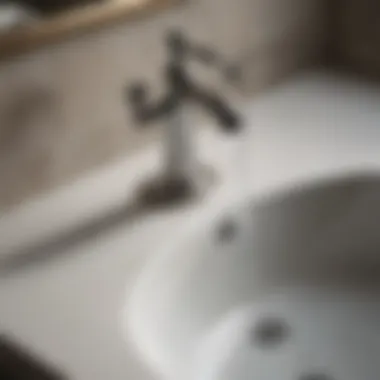
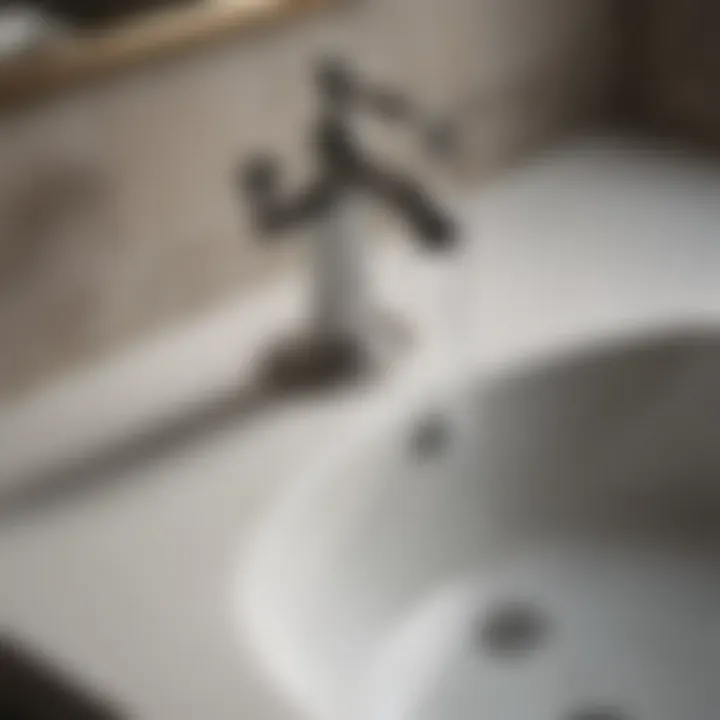
Application Techniques
To maximize the effectiveness of enzyme drain cleaners, it’s essential to apply them properly. Here’s how you can seamlessly incorporate them into your bathroom maintenance routine:
- Select the Right Product: Choose a reputable enzyme cleaner that suits your needs. Verify if it is designed for bathroom sinks specifically.
- Clear the Area: Before application, remove any visible debris from the sink and surrounding area. This helps the enzymes focus on the unseen buildup.
- Follow Instructions: Carefully read the label for specific mixing or application instructions. Some might require dilution, while others can be poured directly into the drain.
- Let It Work: After application, allow the cleaner to sit in the drain for the recommended time. This can range from a few hours to overnight depending on the product. Prevent water flow during this time.
- Rinse Thoroughly: After the waiting period, flush the drain with hot water. This helps to wash away the dissolved material and carries it through the plumbing, clearing the pathway.
- Reapply Regularly: For ongoing prevention, consider using enzyme cleaners on a regular basis. A bi-weekly application can significantly reduce the likelihood of clogs forming.
Utilizing enzyme drain cleaners allows homeowners to maintain their plumbing efficiently and safely. As they promote the breakdown of organic materials while being kinder to the environment, their use can practically transform your approach to drain maintenance.
Preventive Measures to Maintain Clear Drains
Preventive measures play a pivotal role in keeping your bathroom sink drains clear and functioning smoothly. When it comes to domestic plumbing, it’s often the small habits and routines that can save you significant trouble down the road. A glance at your daily practices can reveal a lot. With a little foresight and effort, one can significantly reduce the chances of clogs and slow drainage.
Emphasizing preventive measures minimizes the necessity for intensive and often messy remedies after issues arise. Think of it as a form of self-care for your plumbing system. Just as you maintain your health with good habits, your home has similar needs. An ounce of prevention is worth a pound of cure, as the old saying goes.
Regular Maintenance Practices
Regular maintenance is not just an afterthought; it should be woven into your routine like winding the clock each week. Here are some vital practices:
- Flush with Hot Water: Periodically running hot water down the drain helps loosen any debris that may be accumulating. While boiling water works best, even hot tap water can make a difference.
- Utilize a Drain Cover: Installing a mesh drain cover can catch hair and large particles before they have a chance to go down the pipe. This simple measure pays off handsomely.
- Routine Vinegar and Baking Soda Treatment: Once a month, pouring a mixture of vinegar and baking soda down the drain can help break down grease and build-up, further ensuring that your plumbing remains in tip-top shape.
- Inspect for Leaks: A slow leak might go unnoticed but can cause a fair amount of debris collection over time, potentially leading to a clogged drain. Regularly check under your sink for signs of leaks and tackle them promptly.
These practices take minimal time but can save you from future headaches amid clogged sinks or aggravating drain odors.
Best Practices for Disposal
What we choose to put down the drain can greatly affect its performance. Here are some best practices for disposal:
- Mind Your Food Waste: Never dispose of grease, oil, or food scraps down the sink. Instead, utilize a compost bin or designate a container specifically for food waste.
- Hair Management: If you or your family members have long hair, make it a habit to catch loose strands before they can enter the drain. A hair catcher in the form of a small mesh can do wonders.
- Dispose of Products Responsibly: Items like disposable wipes or sanitary products should never go down the toilet or sink. They contribute significantly to clogs. Always use the trash for disposal.
- Chemical Products: While chemical drain cleaners might offer a quick fix, their use should be limited. They can corrode pipes over time and create additional problems, not to mention the environmental impact.
By adhering to these best practices, you can help to ensure your bathroom sink remains clear, making your life easier and reducing plumbing issues. Taking preventive measures doesn’t require significant effort but pays off heavily in maintaining a clear and functional drainage system.
Signs That Indicate Serious Problems
When it comes to a slow bathroom sink drain, what might seem like a mere annoyance can sometimes signal deeper, more pressing issues. It’s crucial for homeowners and renters alike to be vigilant about the signs that indicate their drainage system may be in trouble. Ignoring these warning signals can lead to more severe plumbing nightmares that are not just inconvenient but can also be costly to fix. Understanding the typical problems your sink may face can save you a lot of time, money, and stress in the long run.
Identifying the Warning Signals
Recognizing the early warning signs of drainage issues is essential for effective home management. Here are some common indicators that something might be wrong with your sink:
- Unpleasant Odors: A persistent foul smell coming from the sink often suggests a clog is forming or that waste is stagnating in the pipes. The sooner it's addressed, the better.
- Gurgling Sounds: Hearing noises like gurgling or bubbling when running water is a classic sign of trapped air caused by blockages. This should not be written off as normal.
- Slow Drainage: If water takes an unusual amount of time to drain, that’s a tangible warning signal. It indicates buildup in the pipes that may soon worsen.
- Visible Discoloration: Any unusual discoloration around the sink area, like stains or spots, could suggest that plumbing issues are manifesting.
- Frequent Clogs: If you find yourself clearing out the sink more often than usual, it’s as if the plumbing is sending you a message — there's more to the problem than meets the eye.
Being attentive to these signs can help prevent minor issues from escalating into significant plumbing catastrophes.
When to Call a Professional
While many drainage issues can be tackled with simple home remedies, some situations demand the intervention of a qualified plumber. Here's when it's time to make that call:
- Persistent Blockages: If home remedies like vinegar and baking soda or hot water severely fail to clear persistent blockages, it may be time to consult a pro.
- Multiple Drains Affected: When other drains in your home, such as the bathtub or toilet, start experiencing slow drainage, you might want to get a professional involved, as it signals a potential main line issue.
- Unusual Water Levels: If water levels in the sink are irregular — either flooding or not draining properly even after attempted remedies — it might suggest a backflow problem.
- Visible Pipe Damage: If you notice any cracks or leaks in your visible plumbing, don't hesitate! Get a plumber in there right away, as addressing it earlier could prevent severe damage.
- Recurring Issues: If you're constantly battling drain problems despite following preventative measures, it may indicate tree roots in the lines or other complex issues best handled by a professional team.
Calling a plumber could seem like an unnecessary expense, but when you’re faced with significant plumbing problems, their expertise is invaluable and often saves you from far more expensive damage down the line.
Monitoring signs of trouble might feel tedious, but sometimes those small hints are the first cry for help on a bigger issue three steps down the line. Stay alert and proactive!
Culmination on Home Remedies for Drain Issues
Addressing slow bathroom sink drains isn’t just about fixing an annoyance; it’s about maintaining a functional home environment. In our exploration of effective home remedies, we’ve covered various approaches that utilize accessible ingredients rather than reaching for harsh chemical alternatives. This not only benefits the household but also aligns with a growing trend towards sustainability and health-conscious living.
Emphasizing Practical Solutions: Adopting simple methods like the baking soda and vinegar combo or employing salt and hot water can lead to immediate results. These remedies often resonate with homeowners because they require minimal effort and cost. The satisfaction derived from solving a problem using everyday items can’t be overstated—it’s both gratifying and empowering.
When considering alternatives to expensive drain cleaners, remember that each remedy discussed carries its own benefits. For instance, the enzyme cleaners are gentle yet effective, making them ideal for regular maintenance without the risk of pipe damage associated with some chemical products.
"The best solutions often come from our own kitchens, proving that effective fixes don't need to break the bank."
Recap of the Most Effective Methods
To summarize, the methods outlined here can be summarized as follows:
- Baking Soda and Vinegar: This classic technique works wonders by creating a natural fizz that helps dislodge clogs. The preparation is simple: just mix equal parts and pour down the drain.
- Salt and Hot Water Rinse: The granules of salt not only add weight but also have abrasive qualities, assisting in the breakdown of build-up.
- Dish Soap: Known for its grease-fighting power, dish soap can break down oil residues that accumulate over time, making it a valuable ally.
- Enzyme Cleaners: For a gentler approach, enzyme-based products utilize natural processes to breakdown organic materials, thus clearing pathways without aggressive measures.
Long-term Drain Care Suggestions
To keep your drains in tip-top shape and prevent future slowdowns, consider these long-term strategies:
- Regular Cleaning: Set a schedule, maybe once a month, to apply one of the simple remedies we’ve discussed. It’s easier to maintain than to fix!
- Mind What Goes Down the Drain: Be mindful of what enters the sink—especially hair, soap scum, and food remnants. Using drain catchers can assist in this goal and simplify cleanup.
- Routine Water Tests: Test your water quality periodically. If hard water is a persistent issue, consider investing in a softener to reduce mineral build-up.
- Educate Family Members: Ensure everyone knows what to avoid putting down the drain. Awareness goes a long way in prolonging the life of your plumbing.
By adopting these practices, homeowners can not only address current problems but also set the stage for continued functionality. Maintaining clear drains is a small effort that delivers significant benefits—making the day-to-day routine smoother and ultimately leading to a more comfortable living space.



